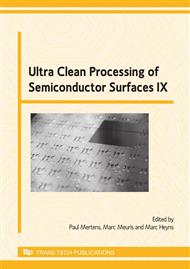p.265
p.269
p.273
p.277
p.281
p.285
p.289
p.295
p.303
Novel Methods for Wet Stripping High Dose Implanted Photoresist Using Sulfur Trioxide
Abstract:
Ion implantation is one of many critical processes in the fabrication of semiconductor devices. While device geometries have been shrinking, the implant dose has typically been increasing. Historically, photoresist removal has been achieved through a combination of plasma “ashing” and a subsequent wet clean, often using a mixture of sulfuric acid and hydrogen peroxide at elevated temperature. The “piranha” or SPM strip is often followed by an ammonia based clean such as APM to remove particles and sulfate residues from the device. However, device constraints are presently having difficulty accommodating the film loss, surface roughening, high molecular temperatures and hot electron injection which may accompany a plasma ash. [1] The APM clean is also having to undergo modification in order to minimize oxide loss which would adversely affect device performance.
Info:
Periodical:
Pages:
281-284
Citation:
Online since:
January 2009
Authors:
Keywords:
Price:
Сopyright:
© 2009 Trans Tech Publications Ltd. All Rights Reserved
Share:
Citation:


